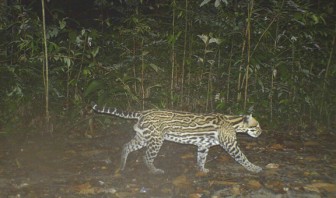The Ocelot (Leoparduspardalis) is an often-seen, spotted, midsized cat, weighing up to 11 kg. It can be mistaken for a jaguar at a distance, but its heavy body and relatively short tail in comparison to the body length helps to distinguish this cat from others.
It is the largest of the small spotted cats and its coloration varies with its habitat. The under parts are tawny yellow with black spots and lines in longitudinal rows and the fur is short, smooth and stiff. The pattern on the neck has heavy black stripes and the fur is ‘reversed’ here and slants forward. The facial patterns are distinct enough that they can be used to identify individuals.
Ocelots can be found from southeastern US to northern Argentina. They occupy a variety of habitats including tropical forest and savannah; their primary requirement is dense vegetative cover.
![]() Ocelots are terrestrial and solitary, both nocturnal and diurnal but often seen at night, when they are travelling on manmade trails. During the day they stay hidden in denser cover and may rest under tree falls and buttressed roots of large trees. Though terrestrial, Ocelots are adept climbers, jumpers and swimmers; their tracks are often found on muddy trails and river banks.
Ocelots are terrestrial and solitary, both nocturnal and diurnal but often seen at night, when they are travelling on manmade trails. During the day they stay hidden in denser cover and may rest under tree falls and buttressed roots of large trees. Though terrestrial, Ocelots are adept climbers, jumpers and swimmers; their tracks are often found on muddy trails and river banks.

Completely carnivorous and capturing their prey on the ground, they feed chiefly on rodents, birds, snakes, lizards and other small vertebrates. They will also catch small fish in shallows and rapids. Not shy, they may also venture into farms and inhabited areas to hunt chickens.
Ocelots are polygynous with the male territory overlapping those of several females. The females take care of the litter. These cats breed year round and will birth one to three kittens. Females may have a litter once every two years. The kittens are weaned by week six and reach full adult size within eight to ten months. They are fully independent within a year and would be tolerated within the mother’s territory for up to two years.
Their conservation status is listed as Appendix I by CITES. The IUCN Red List has not evaluated the status of the species.
Rain forests are rich in biodiversity and are home to many different plants and animals as well as indigenous communities. Humans, even those who don’t live in the rain forest, rely on it for resources such as building materials (wood and lianas), medicine and fruits. Rain forests also provide essential environmental services for life on earth; they create soil as well as prevent soil erosion, produce oxygen though photosynthesis, maintain clean water systems, and are a key defence against climate change.
The Iwokrama Rain Forest is 371,000 hectares, located in the heart of Guyana. Our mission is to develop strategies for conservation and sustainable development for local people in Guyana and the world at large. We are involved in timber, tourism and training. Come and visit us in the rain forest or at http://www.iwokrama.org.




